Inflation expectations among consumers have declined, according to the Federal Reserve Bank of New York’s Center for Microeconomic Data.

The Survey of Consumer Expectations (SCE) contains information about how consumers expect overall inflation and prices for food, gas, housing, and education to behave. It also provides insight into Americans’ views about jobs, earnings growth, and their expectations about future spending and access to credit. The findings about inflation were released as part of the Fed’s July 2023 Survey of Consumer Expectations.
Among the highlights, inflation expectations declined across short-, medium-, and longer-term horizons. They fell from 3.8 percent to 3.5 percent at the one-year-ahead horizon, and from 3.0 percent to 2.9 percent at both the three-year and five-year-ahead horizons.
Further, price growth expectations for food, medical care, and rent declined to their lowest levels since at least early 2021. Labor market expectations strengthened, while households’ perceptions about their current financial situations and expectations for the future improved.
Among other findings, median inflation uncertainty—or the uncertainty expressed regarding future inflation outcomes—declined at the one-year-ahead horizon and increased slightly at the three- and five-year-ahead horizons. Median home price growth expectations decreased from 2.9 percent in June to 2.8 percent in July, remaining well above the 12-month trailing average of 2.0 percent.
Also, the median year-ahead expected price changes declined for all commodities. Specifically, they declined by 0.2 percentage point for gas (to 4.5 percent), 0.1 percentage point for food (to 5.2 percent), 0.9 percentage point for medical care (to 8.4 percent), 0.3 percentage point for the cost of a college education (to 8.0 percent), and 0.4 percentage point for rent (to 9.0 percent). The current readings for food, medical care, and rent are the lowest since September 2020, November 2020, and January 2021, respectively.
In the job market, median one-year-out expected earnings growth decreased by 0.2 percentage point to 2.8 percent, while unemployment expectations—or the mean probability that the U.S. unemployment rate will be higher one year from now—decreased by 1.0 percentage point to 36.7 percent. That is the lowest reading since April 2022.
In addition, the median expected growth in household income was unchanged at 3.2 percent in July and remains below the 12-month trailing average of 3.6 percent. Meanwhile, household spending growth expectations increased from 5.2 percent in June to 5.4 percent in July but is well below its 12-month trailing average of 6.1 percent.
Finally, perceptions about households’ current financial situations improved in July with more respondents reporting being better off than a year ago. And the mean perceived probability that U.S. stock prices will be higher 12 months from now increased by 1.8 percentage points to 37.1 percent.